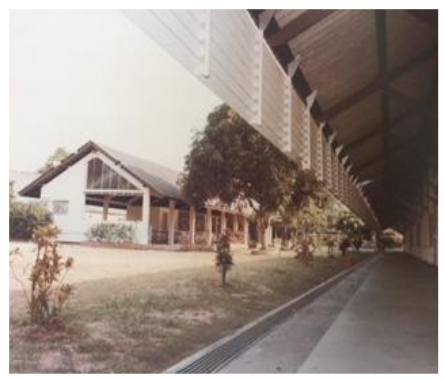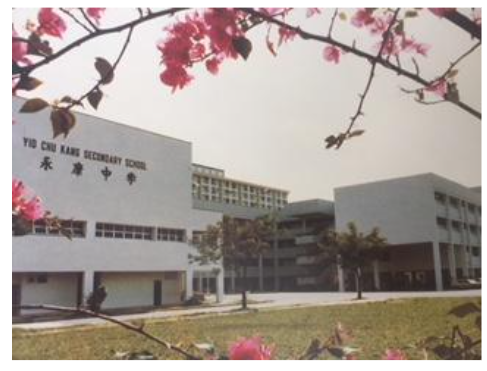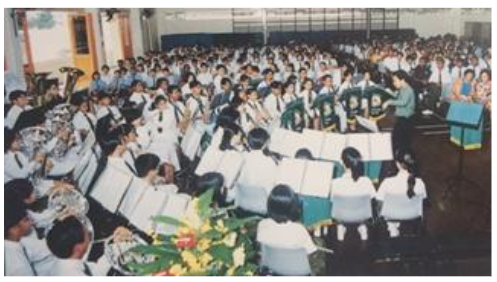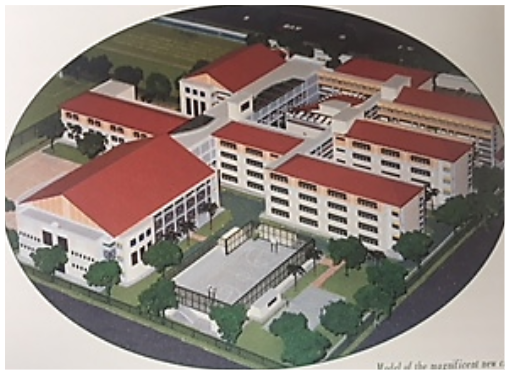History
Founded in 1965, the school was the 61st one established by a newly independent Singapore, and one of two built that year. The school was an answer to requests made personally to PM Lee Kuan Yew by farmers when he visited the rural community of Yio Chu Kang. The original building was sited at the 11th milestone / 16 km Yio Chu Kang Road.
Officially opened by then Minister of Education Mr Ong Pang Boon, it started as an integrated English-Chinese stream school as part of government efforts to house two or more language streams under one administration and one principal. Thus, schools such as Yio Chu Kang Secondary School became a critical strategy in early nation building to emphasise the importance of bilingual education and to increase socialisation of students from different language mediums.
Since then, the school has undergone **four campus transformations**, reflecting closely the growth and challenges of our nation, as well as the aspirations of her students and her community. The story of each campus revolution is a remarkable tale of the steadfast spirit of a school born of humble origins and the valiant efforts to survive and thrive in the face of enormous changes in Singapore’s education, economic and social landscape. In doing so, the school has remained true to her original ideals of Pursuit, Knowledge and Service.
Today, the school continues to be an example of the national social and educational initiatives to meet emerging needs.
In 2014, the school became the second Pathlight Satellite School, hosting students in an innovative commitment to create sustained and regular opportunities for authentic academic and social integration of students with different learning abilities.
In 2018, the school merged with Chong Boon Secondary School. In many fundamental ways, the Merged School seeks to capture the school’s long story and half a century of DNA. It respects the long heritage and deep roots of both schools, while demonstrating through its remarkable story of how it is agile in change.

Through the four main campus transformations in 1965, 1982, 2001, 2018, Yio Chu Kang embodies the spirit of pioneers in working earnestly to improve lives while remaining nimble to stay relevant to the changing needs in the school programmes that are offered.
-
The school, built at the cost of $444K, was officially opened by Singapore’s pioneer Minister of Education, Mr Ong Pang Boon in June 1966. It began operations with 5 classes in two language streams and graduated 37 students that year.
The original school reflected its status as a rural school, consisting of 2 single-storey zinc roofed buildings, a small canteen and a basketball court. There was a very modest field that often flooded. There was no school hall and no sports field and the students walked over to the nearby Pei Hwa Public School for assembly or to use the school field. Students who wished to take Science in upper secondary had to transfer to another school. The school was very creative in its use of space. But gradually, the school outgrew the limitations of her modest facilities.
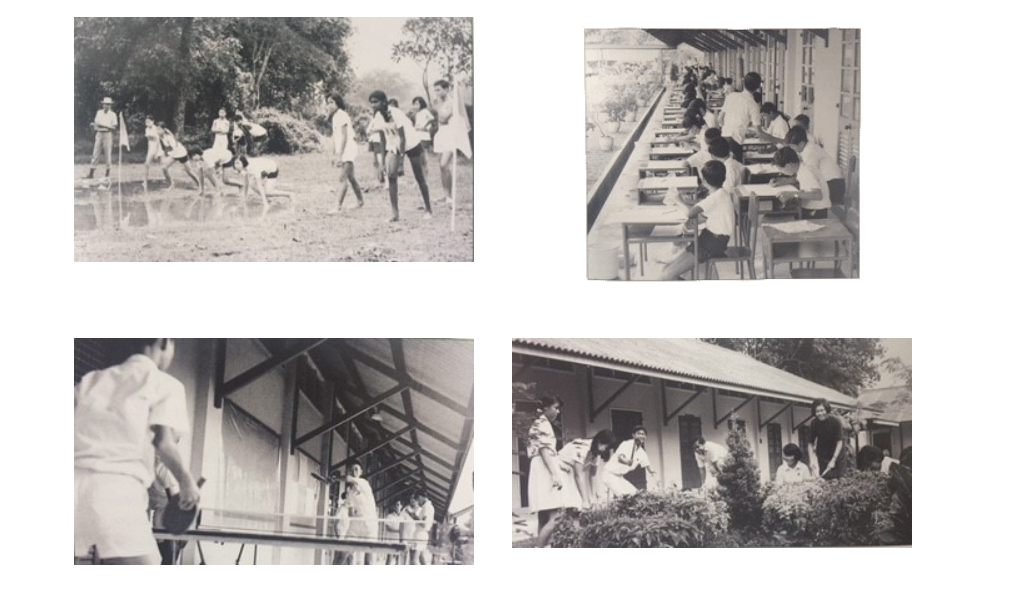
-
In 1982, the school made her first move into a new building, in a new location in Ang Mo Kio to meet the needs of the community. The new facilities also reflected the new national curriculum, which enabled all students access to standard facilities such as spacious classrooms, technical workshops, computer and science labs. The provision of a library and a language lab reflected the national move to adopting English as a first language in all government schools and a phasing out of other language medium schools.
Also welcomed were a sports field, paved areas for parade practices and court games and a large hall with a good stage for performances.
These facilities enriched the school programmes the school could offer. Students did not need to travel to another school to use basic facilities such as the hall or the field. The school thrived with greater diversity of CCA programmes and talents in performing arts. The vibrancy of the performing arts scene in the school made possible highlights to come.
In 1984, 700 students participated in the mass dance display at the National Day Parade, bringing national attention to the school. This has seeded a tradition of the school in building talents in the performing arts. The school participated in two more National Day Parade Mass Displays in 2010 and 2017.
Through the school’s vibrant arts programme, students were able to pursue interests in these areas. One prominent celebrity to emerge from this was Pan Ling Ling. Today, this legacy can be seen in the school’s choice of distinction in the Learning for Life Programme (LLP) focused on the Arts, Media and Design.
Again, the school’s programme needs soon outstripped the limitations of the facilities. For instance, many of the performing arts groups held their practices in the corridors of the classrooms. It was time to move to bigger premises again!
-
In 2000, the school was selected as one of the first schools to benefit from the inaugural Programme to Rebuild or Improve (PRIME) existing schools. The new school was built in 2001 on site but the land it occupied was vastly expanded with a new main entrance from Ang Mo Kio Avenue 5.
It was designed with modern facilities, incorporated into a village concept of the original rural school. This is seen clearly in the long, wide, covered pavement leading from the main entrance to the school hall. This recreates the long path that formerly led to the main house of the village headman.
To reflect the school’s Arts niche programmes, non-standard facilities of dance and band studios, and an outdoor performance area were incorporated. This required an additional $256K in funds which was raised with SAC help. The unusual rounded stairwell outside the hall created a vertical rock climbing wall. This was inspired by the common rural activity of climbing fruit trees and echoes the rural origins of the school.
A prominent feature of the school building was the school hall. Over the years, successive upgrades were made to enhance its ability to host performing arts groups. At one point, the school even adopted the tagline of “School of the Arts” to reflect its deep connection in this niche. In 2008, the hall was officially opened as the Performing Arts Theatre.
Informally, it is known as the original SOTA, referencing Singapore’s first pre-tertiary specialised arts school set up by the government in 2008 bearing this name. In 2016, the name was removed from the school hall. Remnants of this name is still visible in the faint etching of this tagline encircling the school logo displayed above the school stage in the hall.
Progressively, the school has made several upgrades and introduced new facilities that reflect changes to programmes offered to students. This include the creation of the Animation Lab, The I-Cube, the Gym and the Indoor Sports Hall, synthetic turf for the school field and a synthetic flooring for sports in the parade square.
-
In 2017, with the anticipated changes to the school as a Merged School, a growing Pathlight Satellite School, and to cater to more small group teaching, some classrooms were installed with partitions. Fortunately timed with the merger was the General Renovation and Repair (GR&R) Exercise at the end of 2017, during which the entire school was repainted with a fresh colour scheme and a new look was given to the school foyer and the staff cabinets outside the main staff room.
To echo the Merged School identity, a new school sign was erected at the main gate to display the name of the school in English and the adoption of Chong Boon’s Chinese name, 崇 文 中 学. Forty-Nine Solar Panels from Chong Boon, a legacy of her strong environmental education programme, were installed in Yio Chu Kang Secondary School.
To accommodate the larger staff and student strength due to the school merger, several changes were made to the existing infrastructure. This included a new staff room that was set up on level 3 to accommodate the English Department. To make room for more classes for teaching and learning, the Needlework room was converted into a normal classroom with flexible configuration. Several open spaces were converted into study hubs for student to gather after school hours. This gave students additional options to do self-study, hold consultations with teachers, or to hold discussions with schoolmates and collaborate informally on learning projects.
As a satellite school for Pathlight School, 14 classrooms were converted progressively since 2014 for Pathlight students.
In 2017, a new classroom block was constructed to provide YCKSians with additional classrooms and a covered void deck for student activities. The new block was opened for use on 2 Jan 2020 with the Secondary Four and Five students occupying it.



